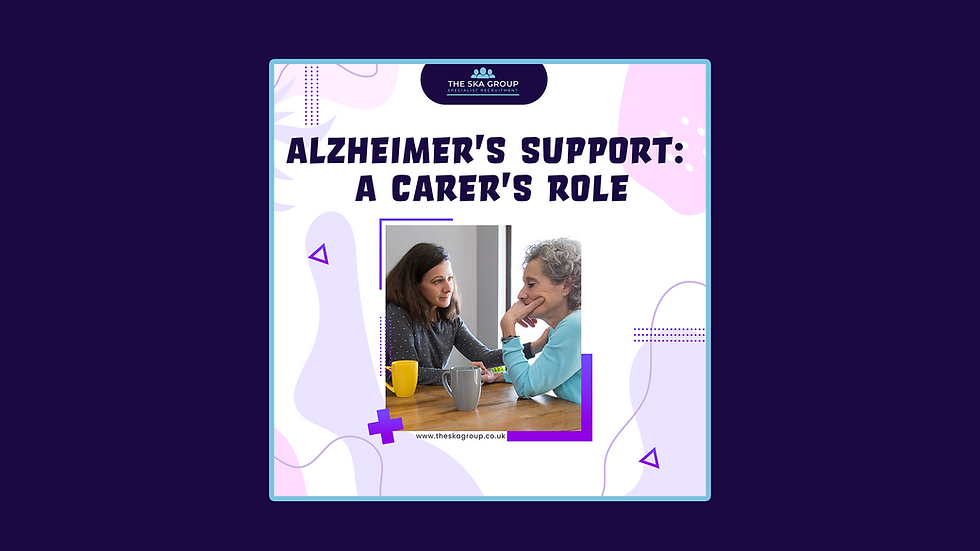Understanding Hidden Disabilities
- Emily

- Jul 22
- 4 min read
When we think of disability, our minds often jump to what we can see - a person using a wheelchair, someone with a guide dog, or an individual using sign language. These visible signs help shape public perception, but they only tell part of the story.
During Disability Pride Month, it’s time to broaden our lens and celebrate all disabilities - including those we cannot see. Hidden (or invisible) disabilities affect millions of people around the world and deserve just as much understanding, accommodation, and pride.
What Are Hidden Disabilities?
A hidden or invisible disability is any physical, mental, or neurological condition that is not immediately obvious to others. These conditions can impair a person's ability to perform daily tasks, communicate, process sensory information, or manage physical health - despite an outward appearance of health.
Examples include:
Autism spectrum disorder (ASD)
Attention deficit hyperactivity disorder (ADHD)
Dyslexia and other specific learning differences
Chronic fatigue syndrome (ME/CFS)
Chronic pain and fibromyalgia
Epilepsy
Hearing or vision impairments not immediately noticeable
Anxiety, depression, PTSD, and other mental health conditions
Diabetes and other metabolic disorders
Multiple sclerosis (MS)
It’s important to note that many of these conditions vary in severity and presentation - no two people experience them in exactly the same way, and because there’s no visible sign, individuals may face judgment, scepticism, or a lack of understanding.
living with a hidden disability
Living with a hidden disability can be incredibly isolating. Often, individuals experience coping with their condition while constantly having to justify or explain their needs to others.
Here are just a few of the challenges people face:
1. Disbelief or Doubt
When symptoms aren’t visible, people may assume someone is exaggerating, lazy, or attention-seeking. This lack of belief can be exhausting and demoralising.
2. Lack of Accommodations
Without visual cues, individuals may not receive the adjustments or support they need in public spaces, workplaces, or social settings.
3. Fear of Disclosure
Due to stigma or past negative experiences, people with hidden disabilities may avoid disclosing their condition, even when support could help. This can lead to worsening health, isolation, or reduced performance in work or education.
Reframing Our Understanding of Disability
Disability is not only about what someone can’t do - it's also about how society responds to difference. A more inclusive world is one where we remove barriers, both physical and attitudinal.
The Social Model of Disability teaches us that people are not disabled by their conditions alone, but by the obstacles and exclusions placed in their way.
For someone with a hidden disability, these might include:
Sensory overload in busy environments
Rigid work or care schedules that ignore energy limitations
Misinterpretation of behaviour as rudeness or irresponsibility
Inaccessible signage or communication styles
Changing the environment and the conversation can make a world of difference.
What Carers, Friends, and Colleagues Can Do
Whether you're a professional support worker, a colleague, or a loved one, your actions can help create an environment of safety and respect.
1. Believe People
When someone discloses their condition, don’t question their experience. Believe them. Trust is the foundation of supportive care and inclusive relationships.
2. Ask, Don’t Assume
Everyone experiences their disability differently. Instead of assuming what someone needs, ask how you can help or what works best for them.
Try: “Would you like me to adjust the lighting?”Or: “Would a break help you feel more comfortable?”
3. Respect Energy Limits
Many hidden disabilities involve fluctuating energy levels or symptoms that come and go. A person might be fine one day and exhausted the next. Honour those rhythms without judgment.
4. Support Disclosure, Not Pressure
Let people decide if and when to talk about their disability. Make your environment safe for disclosure by being non-judgemental, confidential, and empathetic.
5. Educate Yourself and Others
Show initiative by learning more about conditions like autism, ADHD, or fibromyalgia. The more we know, the better we can support others - and ourselves.
Language Matters
Avoid phrases that minimise or question someone’s reality. Here are some swaps to consider:
Kind, inclusive language opens doors to connection and trust.
Disability Pride: More Than Visibility
Disability Pride Month is about celebrating all aspects of disability identity - not just visibility, but authenticity, autonomy, and inclusion. It’s about challenging outdated narratives and uplifting the voices of people whose experiences have long been ignored.
For those with hidden disabilities, this is especially powerful. It’s a chance to take up space, tell their stories, and know they belong - no explanation needed.
Final Thoughts
Everyone deserves to live without fear of judgment, and with access to the support and accommodations they need to thrive. Hidden disabilities might not be visible, but they are very real - and so is the strength it takes to live with them.
This Disability Pride Month, let’s go beyond the label. Let’s foster a culture of belief, compassion, and inclusion - where every kind of disability is seen, respected, and celebrated.




Comments